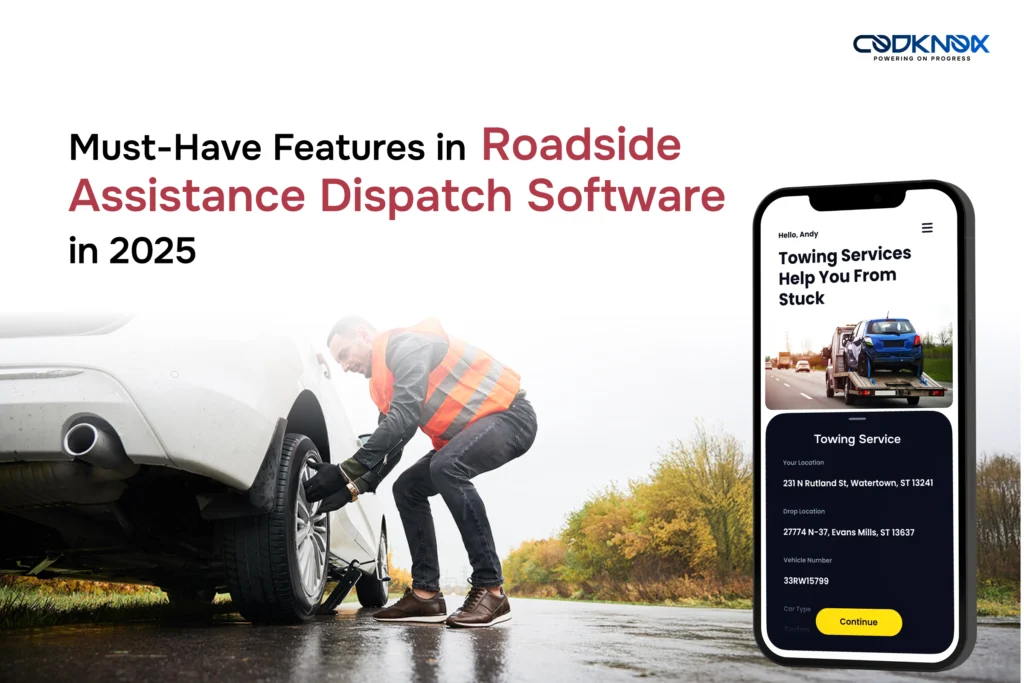
Must-Have Features in Roadside Assistance Dispatch Software in 2025
The tow truck market size is projected to grow from $1.62 billion in 2024 to $1.69 billion by the end of 2025 at a CAGR of 4.5%. The demand in the market can be attributed to the vehicle ownership growth, road traffic accidents, urbanization, increased commercial fleets, or weather-related incidents. To meet the demand, roadside assistance dispatch software has become an essential tool for recovery and towing companies. Traditional dispatching methods rely on manual labor, which can result in ignored requests, delayed responses, all of which lead to dissatisfied customers. Firms can utilize modern technologies to automate task assignments and increase user satisfaction. Vehicle recovery software offers useful features such as real-time tracking, automated billing, tasks, instant job assignment, and much more. Before we discover all of these features and their role, first let’s understand what it is and what benefits it offers. So, without any further ado, let’s begin. What is a Roadside Assistance Dispatch Software? A roadside assistance management software is a digital tool through which a towing business can offer its services seamlessly. The software entails services such as towing, jumpstart, tire changes, battery jump start, fuel delivery, swift roadside repair, EV charge, and much more. It also assists in everyday tasks of tow companies like tow truck dispatching, tracking driver location, managing incoming service requests, and processing payments. Why Tow Businesses Should Invest in Fleet Assistance Software? In today’s fast-growing roadside service industry, towing service providers must include services beyond manual dispatching and adopt advanced solutions. This is where fleet assistance software becomes a game-changer. The software is created to ease a towing business’s everyday tasks and accelerate incoming orders. With the use of robust software, you can streamline operations and elevate real-time coordination. There are numerous software programs available in the market, some of which work fantastically and deliver great results. One of those tow software is TowingKnox, a tow truck dispatch software that is built to organize your towing operations. A towing management software enables organizations to; Track tow trucks using GPS Assign a job instantly Optimize routes Track vehicle location All these from a centralized dashboard. As a business owner in 2025, one must think of innovative solutions. Just imagine- with the help of a program, you can stop depending on time-consuming phone calls or paperwork. With this, dispatchers can use roadside assistance dispatch software to manage tasks in real-time and more efficiently. Moreover, the software’s capacity for making an error is next to zero, which proves to be advantageous in emergency scenarios. With automated scheduling, service logging, and integrated billing, companies can focus more on offering exceptional services rather than dealing with administrative hurdles. Core Features of Roadside Operations Software 1. Real-Time GPS Tracking With the help of this feature, you can monitor the location of all your tow trucks in real time. GPS tracking assists dispatchers in allocating the nearest available driver, decreases fuel costs, and ensures faster service. 2. Instant Job Assignment Unnecessary delays can be avoided with the help of a towing service software. Admin can assign the job as soon as a request is received to the nearest driver. This feature reduces idle time and enables quicker response to emergency calls. 3. Route Optimization Now you can deliver services faster by automating the selection of the easiest and efficient route. Yes, with route optimization, drivers can avoid traffic, poor road conditions, and distance to reach the consumer in less time. 4. Service Request Management With the use of digital roadside management, companies can easily manage incoming roadside requests from a centralized dashboard. The request can address several issues, such as a flat tire, battery jump, or a tow. 5. Driver Communication Tool Often, drivers face difficulty while connecting with the team. With the implementation of a functional towing operations software, drivers can stay connected effortlessly by using built-in messaging and alerts. Additionally, these tools allow dispatchers to share job details, route updates, and safety instructions with drivers in real-time. 6. Automated Billing & Invoicing A vehicle recovery dispatch software can create and send an invite automatically after a job is completed. The usage of this feature reduces the need for desk work, enables fast and secure payment, and avoids the tiniest billing errors. In addition, you can easily track payment updates, send reminders, and manage your business finances. 7. Smart App for Drivers Drivers are the sole source that connects you with your customers. There needs to be a transparent and quick communication method between you and your drivers. The best way to do this is via a dedicated mobile app. A functional and customized mobile application can assist you in receiving assignments, viewing user personal and important details, navigating routes, and updating job status in real-time. The app empowers drivers to stay connected- even when they’re on the go. You can have a personalized app for your towing business in weeks with us. Yes, our white-label towing dispatch software, TowingKnox, integrates seamlessly with your operations. It can be customized to match your brand identity, workflow, and service model. Our skilled developers can develop specific features for job tracking or communication tools. TowingKnox adapts to your needs, offering a modern solution for your entire fleet. 8. Service History An on-demand towing service software allows you to maintain a detailed record of every request call, including job type, time, location, driver, and user feedback. This data storage helps you discover recurring problems, resolve disputes, improve future service, and understand consumer preferences and needs. Benefits of Using Dispatch Software for Towing Companies Dispatch software assists towing companies to boost productivity, efficiency, reduce operational costs, and deliver more reliable service, eventually driving higher sales and consumer retention. Improves job completion rates through faster dispatching Enhances user experience and satisfaction with accurate ETAs and real-time updates Supports business scalability without increasing overhead costs Helps establish a professional presence with a white-label mobile app Minimizes fuel and maintenance costs through route optimization Reduces delayed jobs with automated scheduling Regulates invoicing and payments
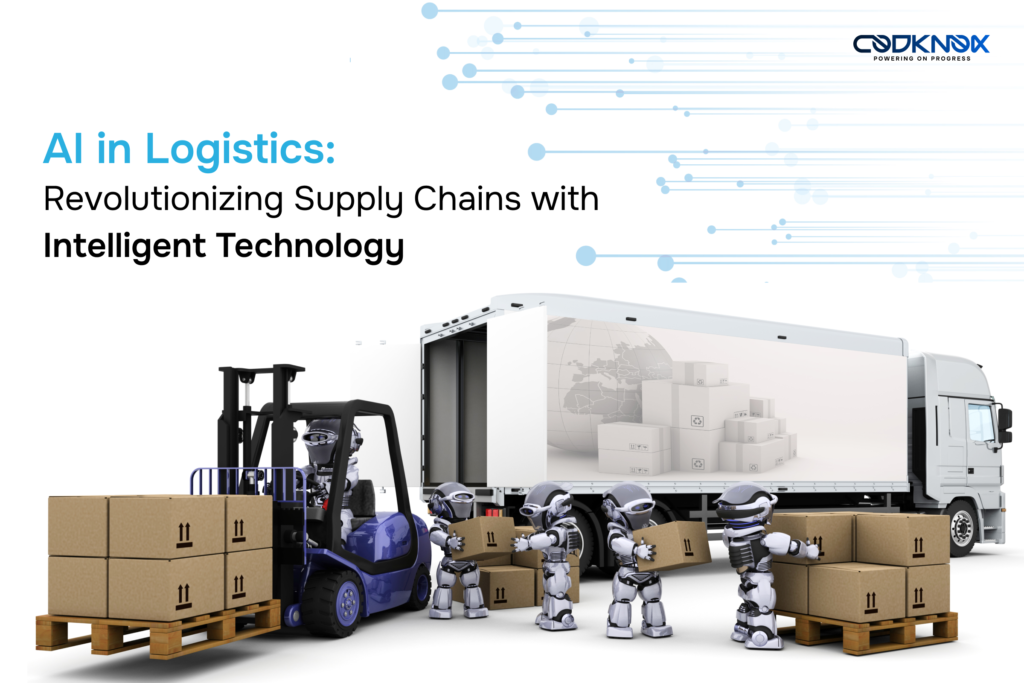
AI in Logistics: Revolutionizing Supply Chains with Intelligent Technology
The logistics industry stands on the brink of a technological revolution, and Artificial Intelligence (AI) is leading the charge. In an era where speed, accuracy, and cost-efficiency define success, AI is transforming traditional logistics operations into smart, data-driven ecosystems. At Codknox, a premier logistics software development company, we empower businesses to harness the full potential of AI in transportation and logistics, helping them optimize operations, reduce overheads, and deliver superior customer experiences. This comprehensive guide explores the tangible benefits of AI in logistics, the real-world applications driving industry change, key challenges and how to overcome them, and how an expert AI development company is crucial in reshaping logistics through the power of AI. The Tangible Benefits of AI in Logistics AI delivers concrete operational and financial advantages that logistics providers cannot afford to ignore: 1. Route Optimization and Cost Reduction AI algorithms process real-time traffic data, weather patterns, delivery windows, and vehicle performance metrics to calculate optimal routes. For example, UPS’s ORION system (On-Road Integrated Optimization and Navigation) saves $300–400 million annually by reducing delivery miles. (Source: UPS Newsroom) Impact: Reduces fuel consumption by 10–15% and improves on-time delivery rates 2. Predictive Demand Forecasting AI analyzes historical sales, market trends, and external factors to optimize inventory levels. For example, Walmart’s AI-powered supply chain reduces excess inventory by 20% while maintaining product availability. (Source: Walmart Corporate) Impact: Lowers warehousing costs and minimizes stockouts 3. Warehouse Automation AI-driven robotics systems handle picking, packing, and sorting with greater speed and accuracy than human workers. For example, Amazon’s fulfillment centers using Kiva robots process orders 2.5 times faster than traditional methods. (Source: Amazon Science) Impact: Reduces operational costs by 15–20% while increasing throughput 4. Predictive Fleet Maintenance AI monitors vehicle sensors and performance data to predict maintenance needs before failures occur. For example, DHL’s predictive maintenance system reduces unplanned downtime by 30%. (Source: DHL Logistics Trend Radar) Impact: Extends vehicle lifespan and improves safety compliance 5. Enhanced Customer Service AI-powered tracking systems and chatbots provide real-time shipment updates and automated customer support. For example, FedEx’s AI chatbots handle over 60% of customer inquiries without human intervention. (Source: FedEx Newsroom) Impact: Reduces support costs while improving customer satisfaction AI in Transportation and Logistics: Applications Transforming Logistics Operations AI in logistics is being deployed across the entire logistics value chain: Overcoming Challenges in Adoption of Artificial Intelligence in Logistics While there are significant benefits of AI in logistics, implementation presents several challenges: While AI offers immense potential for logistics, implementation faces hurdles like high costs, legacy system integration, talent shortages, and regulatory compliance. These stem from the gap between traditional operations and advanced AI needs. Solutions include phased cloud rollouts, API middleware, partnering with AI specialists, and built-in compliance features. Industry leaders prove these challenges are manageable with proper strategy and expertise. Industry Insight: According to PwC’s 2023 Global Logistics Report, 58% of logistics providers cite integration with existing systems as their primary AI adoption challenge. (Source: PwC Transportation & Logistics Trends) Why Partner with Codknox for AI Logistics Solutions? As an experienced logistics software development company, Codknox delivers: Custom AI solutions tailored to specific logistics needs Seamless integration with existing WMS and TMS platforms Predictive analytics for demand forecasting and route optimization Real-time tracking systems with AI-powered exception management Comprehensive security and compliance frameworks Request a free consultation to learn about our logistics software development services and see how we can transform your operations. The Future of Artificial Intelligence in Logistics The innovation in AI converges toward an intelligent, responsive logistics ecosystem where AI doesn’t just optimize operations but fundamentally reimagines supply chain relationships and capabilities. Some key emerging developments that will shape the industry: 1. Autonomous Freight Transportation Self-driving trucks represent a transformative leap in logistics efficiency. By leveraging advanced sensor arrays, machine vision, and predictive algorithms, autonomous freight vehicles can operate continuously without driver fatigue restrictions. McKinsey’s research indicates this technology could reduce long-haul transportation costs by 25% by 2030 (Source: McKinsey Future of Mobility) 2. Blockchain-Enabled Supply Chains The fusion of AI with blockchain creates an immutable, transparent ledger for logistics operations. This combination enables: Real-time verification of shipment conditions (temperature, handling, etc.) via IoT sensors Automated smart contracts that trigger payments upon delivery confirmation Tamper-proof documentation for customs and compliance Enhanced fraud detection through pattern recognition in shipping documents Major shipping conglomerates like Maersk are piloting these solutions through platforms like TradeLens, demonstrating 40% faster customs clearance in test cases. The blockchain layer ensures data integrity, while AI extracts operational insights from the accumulated data. 3. Sustainability Optimization AI-driven green logistics solutions analyze multiple variables to minimize environmental impact: Dynamic route optimization considering traffic, weather, and road gradients Load consolidation algorithms to reduce empty miles Predictive maintenance reducing emissions from poorly maintained vehicles Modal shift recommendations (e.g., rail vs. truck for certain legs DHL’s Green Optimization program has shown 15-20% emission reductions in European networks using such AI tools. The technology helps balance cost efficiency with sustainability KPIs as carbon taxation becomes more prevalent. 4. Hyper-Personalized Logistics AI enables unprecedented delivery customization by analyzing: Individual customer preference patterns (time windows, locations) Predictive arrival times with 30-minute accuracy windows Dynamic alternative delivery points (lockers, neighbor options) Personalized packaging and handling instructions Amazon’s anticipatory shipping models and FedEx’s SenseAware services exemplify this trend, where AI processes historical data, weather forecasts, and real-time traffic to tailor last-mile experiences. Early adopters report 35% higher customer satisfaction scores compared to standard delivery options. Implementing AI for Logistics Success The integration of AI in transportation and logistics represents a fundamental shift in how supply chains operate. Companies that embrace these technologies now will position themselves as industry leaders in: Operational efficiency Cost reduction Customer satisfaction Sustainability Codknox stands ready to help your organization navigate this transformation with proven AI solutions and logistics software development services tailored to your specific logistics challenges. Contact our logistics AI specialists to begin your digital transformation journey with winning logistics software development.
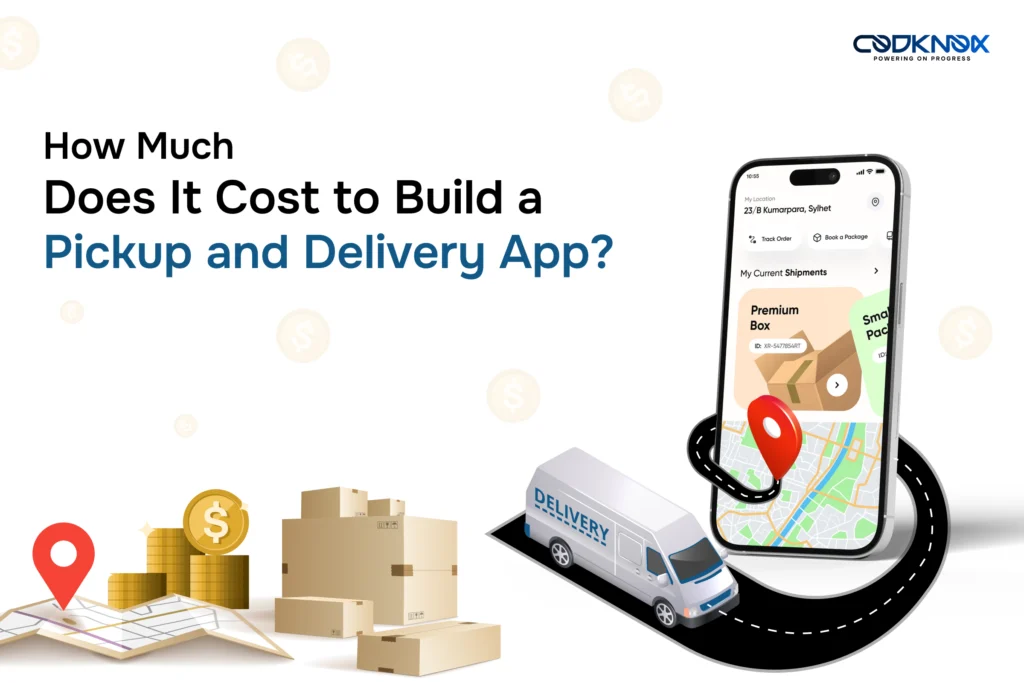
How Much Does It Cost to Build a Pickup and Delivery App?
Today, on-demand pickup and delivery apps have become essential tools for businesses aiming to meet consumer expectations for swift and efficient services. Whether you’re a startup or an established enterprise, understanding the costs associated with developing such an app is crucial. This comprehensive guide will break down the factors influencing the cost, provide market insights, highlight the top features of a successful app, and explain why partnering with a top on demand pickup and delivery app development company in New York is essential. Market Insights from the US On-Demand Delivery Industry The on-demand delivery market in the U.S. is witnessing exponential growth, driven by changing consumer behavior and advancements in mobile technology. U.S. Last-Mile Delivery Market: According to Grand View Research, the global last mile delivery market was valued at $132.71 billion in 2022 and is expected to grow at a CAGR of 8.8% from 2023 to 2030. (Source) Food Delivery Market: Statista projects that the global online food delivery market will reach $1.40 trillion in revenue by 2025. (Source) E-commerce Delivery Services: Grand View Research reports that the global e-commerce logistics market was valued at $315.82 billion in 2022 and is expected to grow at a CAGR of 22.3% from 2023 to 2030. (Source) These numbers indicate a thriving industry with huge opportunities for businesses looking to invest in on-demand pickup and delivery app development. Factors Influencing the Cost of Building a Pickup and Delivery App 1. App Complexity and Features The complexity of your app significantly impacts development costs. A basic app with essential features like user registration, order placement, and tracking will cost less than an advanced app incorporating real-time analytics, AI-driven recommendations, and multi-language support. Each additional feature increases the development time and resources required. 2. Platform Selection Deciding whether to develop your app for iOS, Android, or both platforms affects the overall cost. Developing for both platforms simultaneously (cross-platform development) can be more cost-effective than building separate native apps but may come with trade-offs in performance and user experience. 3. UI/UX Design An intuitive and engaging user interface is vital for user retention. Investing in quality UI/UX design ensures a seamless user experience but can increase development costs. Complex designs with custom animations and interactive elements require more development time. 4. Development Team’s Expertise and Location The cost of hiring a development team varies based on their expertise and geographical location. For instance, partnering with a top mobile app development company in New York may entail higher costs compared to teams in regions with lower living expenses. However, experienced developers can deliver a more polished product efficiently. 5. Backend Infrastructure and Third-Party Integrations A robust backend is essential for managing user data, processing orders, and ensuring smooth app performance. Integrating third-party services like payment gateways, mapping services, and notification systems can add to the development cost but enhance functionality. Estimated Cost Breakdown While costs can vary widely based on the factors mentioned, here’s a general breakdown of the estimated expenses involved in developing a pickup and delivery app: Note: These figures are approximate and can vary based on specific project requirements and the development team’s rates. Which Businesses Can Benefit from an On Demand Pickup and Delivery App? A well-built pickup and delivery app can benefit a wide range of industries. 1. E-commerce & Retail With online shopping booming, businesses need seamless logistics to ensure timely deliveries. A pickup and delivery app enables e-commerce platforms and retail stores to manage order fulfillment efficiently, track shipments in real time, and offer customers flexible delivery options. This improves customer satisfaction and reduces cart abandonment rates. 2. Food & Beverage Industry Whether it’s a high-end restaurant, a fast-food chain, or a cloud kitchen, food businesses must ensure quick and hassle-free deliveries to retain customers. A robust delivery app allows them to accept online orders, manage delivery personnel, and provide real-time tracking, ensuring fresh and timely food delivery. 3. Grocery & Supermarkets The demand for online grocery shopping has surged, making it essential for supermarkets and grocery stores to offer fast and reliable delivery services. A pickup and delivery app helps streamline order processing, optimize delivery routes, and provide real-time tracking, ensuring groceries reach customers at their convenience. 4. Courier & Logistics Services Logistics companies and courier services can significantly enhance efficiency with automated scheduling and tracking features. A pickup and delivery app enables businesses to optimize routes, reduce delivery time, and offer customers live tracking updates, improving transparency and trust. 5. Laundry & Dry Cleaning Services Laundry and dry cleaning businesses can elevate their customer experience by offering convenient pickup and delivery services. An app allows users to schedule pickups, receive status notifications, and track their laundry’s progress in real time, making the entire process hassle-free. 6. Medical & Pharmacy Services In an era where quick access to medicines is crucial, pharmacies and medical supply businesses can use a delivery app to bring essential healthcare products directly to customers. Features like e-prescription integration, contactless payments, and real-time tracking enhance safety and convenience. 7. Home Services From furniture rental and appliance repairs to pet grooming and maintenance services, home service businesses can benefit from a dedicated pickup and delivery app. Customers can schedule services at their convenience, track service professionals in real time, and receive updates, leading to a seamless customer experience. If your business relies on delivering goods or services to customers, investing in a pickup and delivery app can improve customer satisfaction and boost revenue. Build Delivery App with Top Features for a Winning Solution A successful pickup and delivery app must be equipped with user-friendly functionalities that ensure seamless order placement, real-time tracking, efficient route optimization, and smooth payment processes. Below are the essential features categorized into three main sections: User Panel, Driver Panel, and Admin Panel. 1. User Panel (Customers) The user panel is the front-facing section of the app that allows customers to place orders, track deliveries, and manage their transactions effortlessly. A well-designed user panel enhances the customer experience and encourages repeat
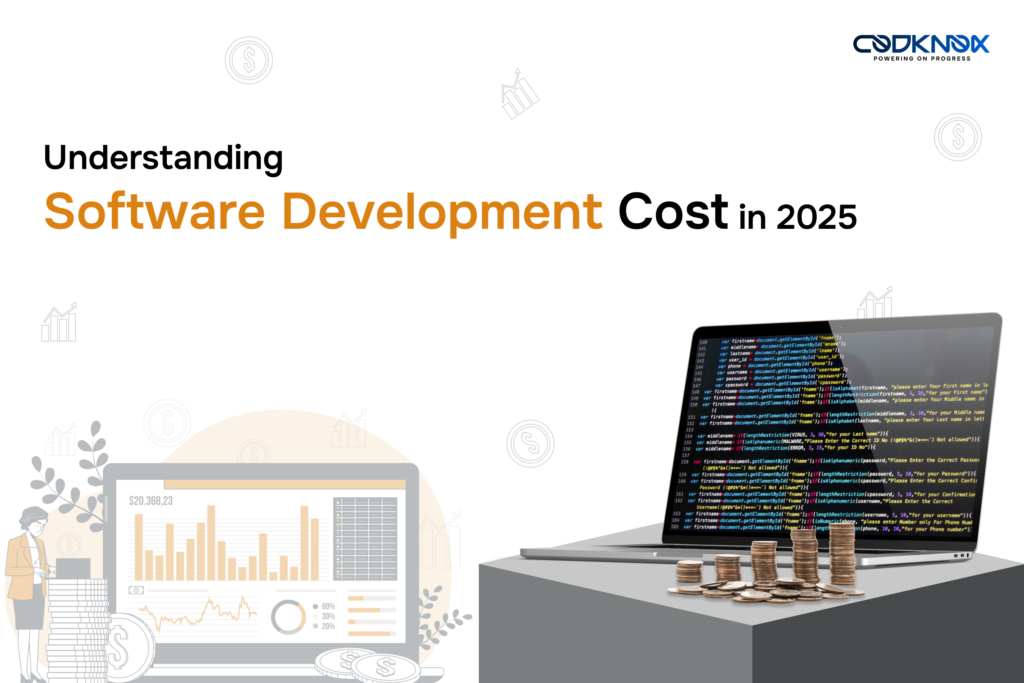
Custom Software Development Cost in 2025
The ongoing transformation brought about by the digital age is significantly impacting various industries, leading to an unprecedented demand for innovative software solutions. For businesses seeking to maintain their competitive edge, it is essential to grasp the costs involved in software development as we look ahead to 2025. Whether the goal is to develop a streamlined mobile application, an extensive enterprise solution, or an interactive web application, understanding the factors that influence costs is crucial for successful project planning and execution. This guide explores the intricacies of software development pricing. From outsourcing software development to the right software development company in New York to balancing functionality and design, we aim to help you navigate the evolving digital landscape with clarity and confidence. Factors Influencing Software Development Costs 1. Type of Software The type of software you aim to develop plays a significant role in determining the cost. Key categories include: Mobile Apps: The cost of developing mobile applications can vary widely based on the type. Native apps, built specifically for platforms like iOS or Android, often demand more resources since each platform requires its unique codebase. If you’re looking for top-notch performance and a seamless user experience, this could be the way to go, but be prepared for a higher investment. Web Applications: When it comes to custom web solutions, the expenses typically rise, particularly when you introduce dynamic content, third-party integrations, or e-commerce functionalities. These features not only enhance the user experience but also significantly add to the complexity and cost of development. Enterprise Software: Tailored for large organizations, enterprise software is a whole different ballgame. These solutions aren’t just off-the-shelf; they require extensive customization, robust security measures, and seamless integration with existing systems. While the investment is higher, the payoff of custom software development in efficiency and productivity can be substantial for large-scale operations. 2. Software Development Team and Location The composition and geographic location of your development team are critical factors: In-House Teams: Building an in-house team involves various costs, including hiring, training, salaries, benefits, and operational overhead. Freelancers: While freelancers can be more budget-friendly, they may sometimes lack the reliability or coordinated approach that established teams offer. Outsourcing: Outsourcing software development to regions like Eastern Europe, South Asia, or Latin America can offer cost savings without compromising quality. However, outsourcing to North America or Western Europe tends to be more expensive due to higher labor costs. 3. Technology Stack The selection of tools, frameworks, and programming languages plays a crucial role in determining overall custom software development project costs. Emerging technologies, including artificial intelligence (AI), blockchain, and the Internet of Things (IoT), typically require specialized expertise and resources, which can further influence expenses. For example, integrating AI-driven features such as chatbots or predictive analytics introduces additional complexity into the development process. Similarly, utilizing advanced technologies like blockchain often leads to increased costs due to the need for specialized knowledge and a deep understanding of the domain. 4. Project Complexity The complexity of your software plays a significant role in determining overall development costs. Several crucial factors come into play: Feature Set: Incorporating advanced functionalities, such as real-time data processing, augmented reality (AR) and virtual reality (VR) integration, or secure payment gateways, can significantly increase the financial investment required. Each of these features not only enhances user experience but also demands specialized knowledge and additional coding, which drives up expenses. Integrations: The process of connecting your software with third-party tools, application programming interfaces (APIs), or existing legacy systems can necessitate extensive development effort. This integration ensures seamless data flow and interoperability, but it often requires careful customization and additional testing, further impacting costs. Scalability: Designing your software with the ability to accommodate future growth is essential for long-term success. This involves thoughtful planning and robust architectural choices that can support increasing user demands and additional functionalities over time. Such considerations may lead to higher initial costs but prove beneficial in avoiding potential bottlenecks as your user base expands. 5. Design and User Experience (UX) A well-designed user interface (UI) and seamless user experience (UX) are essential for software success. Costs associated with this include: Wireframing and Prototyping: Creating initial designs and mockups is essential for ensuring that the project aligns with user expectations and needs. Custom Graphics and Animations: Incorporating personalized design elements can significantly enhance user engagement, though it often leads to increased costs. User Testing: Implementing iterative testing and feedback loops is crucial for improving usability. However, this process demands additional time and resources to be effective. 6. Post-Launch Support Development doesn’t end with deployment. Post-launch support ensures your software remains functional and competitive by addressing bug fixes, adding new features, and optimizing performance. Comprehensive maintenance packages are often available to provide ongoing support, enhancing the software’s longevity and adaptability. Estimated Custom Software Development Costs in 2025 Software development projects in 2025 are classified into different categories based on their scale and objectives. Below is a breakdown of typical cost ranges and examples for various types of projects: White-Label Solutions White-label solutions offer businesses a cost-effective way to deploy software quickly. These pre-built, customizable software products allow companies to brand and market the solution as their own, saving time and resources. They are especially popular for startups and small businesses looking for rapid market entry with minimal investment. Key Cost-Saving Strategies for Successful Project Development By implementing the following comprehensive strategies, you can optimize your project development process, reduce unnecessary costs, and lay a solid foundation for future growth. Define Clear Requirements: Begin your project with an in-depth and detailed project scope. This thorough outline should encompass every desired feature and functionality. By having a clear vision from the start, you can significantly reduce the need for changes and revisions during the development process, which can often lead to increased costs and delays. Choose the Right Development Partner: Selecting the appropriate development team is crucial. Look for collaborators who possess a proven track record in handling similar projects. A knowledgeable partner can help you
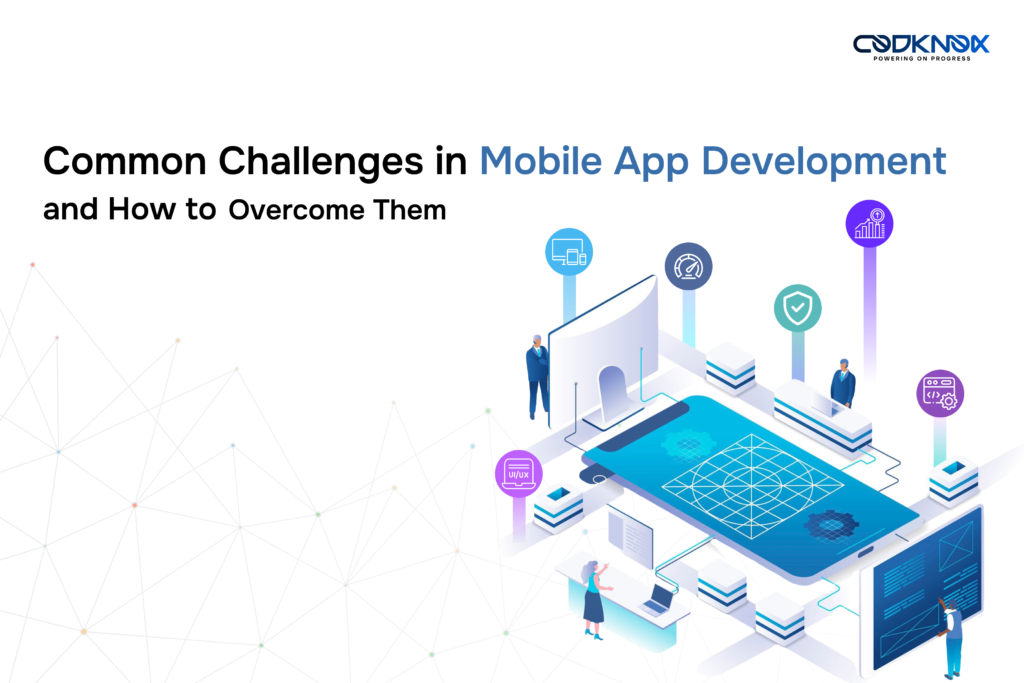
Common Challenges in Mobile App Development and How to Overcome Them
Mobile app development is an ever-evolving industry that presents numerous challenges, from conceptualization to deployment. However, you can easily navigate these challenges by partnering with a top-tier mobile application development company in New York like Codknox. Here, we look at a few typical challenges in the development of mobile apps and how app development experts can get past them. 10 Mobile Application Development Challenges And How To Solve Them? 1. Balancing User Expectations and Business Goals The Challenge: Businesses look for solutions that support their goals, including generating revenue or brand positioning, but users want apps that are quick, easy to use, and aesthetically pleasing. It can be difficult to find balance. The Solution: To make sure the finished product satisfies user expectations and business goals, app development companies that are experts in user-centric design and agile development processes carry out extensive user research, stakeholder interviews, and iterative testing. 2. Ensuring Cross-Platform Compatibility The Challenge: It is difficult to create apps that work flawlessly on multiple platforms (iOS, Android, and others) while preserving a consistent level of performance and design. The Solution: Besides Android and iOS app development in New York, companies like Codknox are experts in building mobile apps with React Native and Flutter. These are two cross-platform technologies that allow developers to build a single codebase for several platforms. These solutions guarantee consistency and cut down on development time. Did you know that — Currently, cross-platform frameworks are used by 87% of developers to create mobile apps. Businesses that use cross-platform development frameworks report significant time-to-market reductions and development cost savings of up to 30%. According to some studies, apps developed with cross-platform frameworks typically have higher user retention rates than their native counterparts—by as much as 20%. Source 3. Maintaining App Security The Challenge: Apps are susceptible to viruses, illegal access, and data breaches, making cybersecurity a serious worry. The Solution: Security is a top priority for New York app development companies right from the start. To safeguard user data, they deploy strong encryption techniques, carry out frequent security audits, and adhere to industry best practices including secure APIs and two-factor authentication. 4. Managing Tight Deadlines and Budgets The Challenge: Resources may be strained as a result of clients’ frequent demands for high-quality apps with constrained budgets and short turnaround times. The Solution: Agile and DevOps techniques are used by experienced app development companies to expedite the development process. They guarantee on-time delivery without sacrificing quality by breaking up projects into smaller, more manageable sprints and automating operations. 5. Adapting to Rapid Technological Changes The Challenge: The difficulty is that the market for mobile apps is always evolving due to changes in user preferences, devices, and operating systems. The Solution: Expert app developers in New York engage in research and development (R&D) and continuous learning to stay ahead of the curve. They ensure that apps stay state-of-the-art and compatible with new technology by keeping their teams informed about the newest tools and trends. 6. Optimizing Performance Across Devices The Challenge: Apps have to function well across a variety of devices with different operating systems, screen sizes, and hardware capabilities. The Solution: With the use of simulations and actual devices, a seasoned app development company in New York carries out thorough performance testing. To guarantee seamless operation on any device, they optimize code and assets. 7. Effective Communication Between Teams The Challenge: Developing a mobile app requires collaboration from several teams, including marketers, developers, and designers. Inconsistencies and delays may result from poor communication. The Solution: Leading mobile app development service providers place a strong emphasis on communicating intelligibly and reliably. To keep everyone on the team informed and in sync throughout the project, they employ collaboration platforms like Jira, Trello, and Slack. 8. Providing Robust Post-Launch Support The Challenge: After the software is out, the work does not stop. Maintaining user engagement and app performance requires regular updates, bug repairs, and feature additions. The Solution: A seasoned app developer in New York offers dedicated post-launch support services. They monitor app performance, track user feedback, and provide timely updates to ensure the app remains relevant and functional. Many also use analytics tools to gather insights for future improvements. 9. Scaling Applications for Growth The Challenge: As user bases grow, apps must be able to handle increased traffic and data without compromising performance. The Solution: The solution is to consider scalability while designing apps. An experienced app development company in New York makes sure that programs can easily handle growth by utilizing microservices design and cloud-based infrastructure. Scalability is further supported through routine performance tuning. 10. Ensuring Accessibility Compliance The Challenge: Apps must adhere to accessibility guidelines in order to serve people with impairments, as inclusivity becomes more and more important. The Solution: To make sure their apps are accessible, New York developers adhere to standards like WCAG (Web Content Accessibility Guidelines). To improve usability for all users, they include features including high contrast modes, text size adjustments, and voice navigation. Endnote Although developing mobile apps can be challenging, skilled mobile app development teams have perfected the art of overcoming these obstacles via innovation, collaboration, and a commitment to quality. By utilizing the newest technology and emphasizing user-centric design, these companies establish industry standards for quality and dependability. Are you trying to realize your idea for a mobile app? Team up with a reputable mobile application development company in New York like Codknox to guarantee the success of your project!
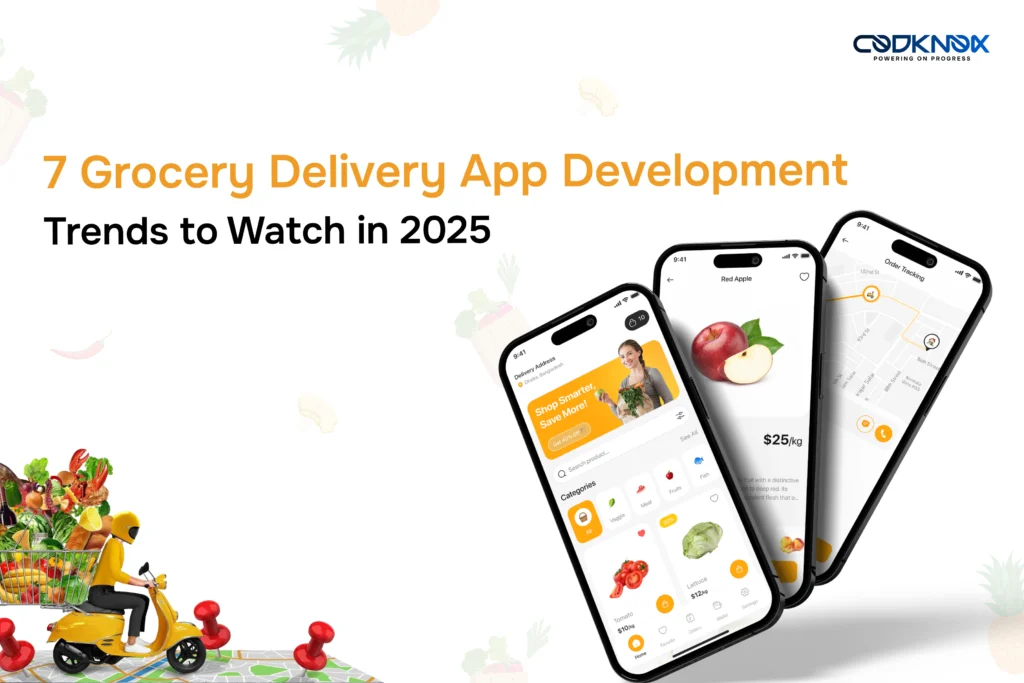
7 Grocery Delivery App Development Trends to Watch in 2025
Imagine giving your customers an easy way to shop for groceries without crowded aisles and long checkout lines. With your app, they can enjoy a simple digital experience that makes shopping more convenient. In 2025, grocery delivery apps are set to transform the grocery industry, providing customers with a smarter and easier way to stock their kitchens. By using the latest technology, your app can create a smooth shopping journey that encourages users to return. For businesses looking to tap into this booming market, grocery app development like Instacart, Amazon Fresh, Walmart, and Shipt is a game-changer. Work with an experienced grocery delivery app development company and make a winning product for your business. Statista So, what can you expect from these futuristic food-fetching apps? Let’s break it down. Grocery Delivery App Development Trends in 2025 1. AI-Based Recommendations and Predictive Shopping The app knows what customers need even before they do. Customers get tired of scrolling through endless aisles. How about giving them a personal grocery assistant? Imagine browsing your grocery app, and it’s already got suggestions for things they’ll need soon. Out of milk? – Check. Favorite snacks? – Got it. AI algorithms analyze customer preferences, shopping frequency, and past purchases to suggest relevant items, from favorite brands to complementary products. Some grocery mobile app development services integrate features that predict what customers might need based on historical data and seasonal patterns, making it easier for users to restock regularly purchased items. Benefit: AI-powered recommendations help customers enjoy a more tailored shopping experience, saving them time while discovering new products suited to their tastes. This not only boosts customer satisfaction but also helps retailers increase average order values and foster loyalty. 2. Real-Time Inventory Management and In-Store Integration Less stress, more trust in your grocery shopping app There’s nothing worse for customers than ordering groceries only to discover that half of them are out of stock. As grocery apps collaborate with local supermarkets and retailers, real-time inventory updates are becoming essential. By 2025, grocery delivery apps are expected to feature more accurate inventory tracking, enhancing both order precision and transparency. Customers will also have the option to browse in-store deals or check aisle-specific availability, giving them the flexibility to pick up items in-store if preferred. Benefit: By integrating directly with in-store systems, grocery apps can provide users with accurate stock information, minimizing the risk of item unavailability and avoiding last-minute replacements. 3. Hyper-Personalized Offers and Loyalty Programs Make your users feel special by giving them deals that matter to them. Who doesn’t love saving money on their favorite items? Grocery apps can use data analytics to create special offers that match individual users. This way, every deal feels like it was made just for them. Imagine an app that knows your preferred products and shows you discounts on exactly what you want. For instance, if a user frequently purchases plant-based products, the app could offer discounts on vegan snacks or fresh organic produce. Benefit: Personalized discounts increase engagement and create a sense of value, as customers feel the app understands their needs. Over time, this level of customization can build strong brand loyalty, turning casual shoppers into regular customers. 4. In-App Nutrition Tips for Health-Conscious Users Healthy choices made easy. In 2025, we could provide grocery mobile app development that makes your app act like a dietitian right in your pocket. More people are becoming health-conscious and looking for apps that can help them. Whether they are following a specific diet or trying to eat healthier, your app can offer the guidance and support they need. For instance, with nutrition tracking and dietary insights, you can set preferences (think gluten-free, high-protein) and get product suggestions tailored to your health goals. Benefit: This health-focused feature adds value and attracts a niche market of customers who prioritize wellness. It positions your app as more than just a grocery delivery service. It becomes a wellness partner, driving loyalty among health-conscious consumers. 5. Collaborations with Local Farms and Artisanal Producers Support local businesses and offer fresher food. More consumers are choosing to support local businesses and buy fresh farm products. Working with nearby farms and artisanal producers gives you more options for organic, seasonal, and fresh products. Your grocery shopping app development can help customers find farmers’ markets and local artisanal producers. Buying local food helps local businesses and encourages healthier eating options. This benefits both your customers’ taste and the farmers. Benefit: Local product integration builds a community-oriented brand image and attracts a niche market of users who value freshness and sustainability. It also helps small vendors reach a broader audience, creating a mutually beneficial relationship that enhances your app’s appeal. This feature sets your app apart from larger chains, offering a curated selection of local goods. 6. 24/7 Customer Support with AI-Powered Chatbots Enhanced customer service for a delightful shopping experience. Customer service is critical, especially when users need answers fast. AI-powered chatbots allow you to provide instant responses to common queries, like delivery updates or return processes, reducing wait times and enhancing the user experience. Chatbots can also escalate cases to human agents during business hours for more complex issues. Benefit: Reliable customer service builds trust and satisfaction, especially in a market where timely responses are critical. 7. Predictive and Same-Day Delivery Options Because sometimes customers just can’t wait. Think same-day delivery is great? Try two-hour delivery delight! Same-day delivery has been a staple of grocery apps for a while, but with advancements in predictive logistics, 2025 will likely see improvements in speed and efficiency. With predictive delivery leveraging AI, grocery shopping app development helps anticipate user needs and will know exactly what items are high in demand and keep them in stock for faster delivery. Apps may also offer “instant delivery” on high-demand items, guaranteeing arrival within a few hours. Benefit: Faster delivery options attract a broader audience, including last-minute shoppers. Same-day or predictive delivery can boost sales and customer loyalty, as convenience is a top priority
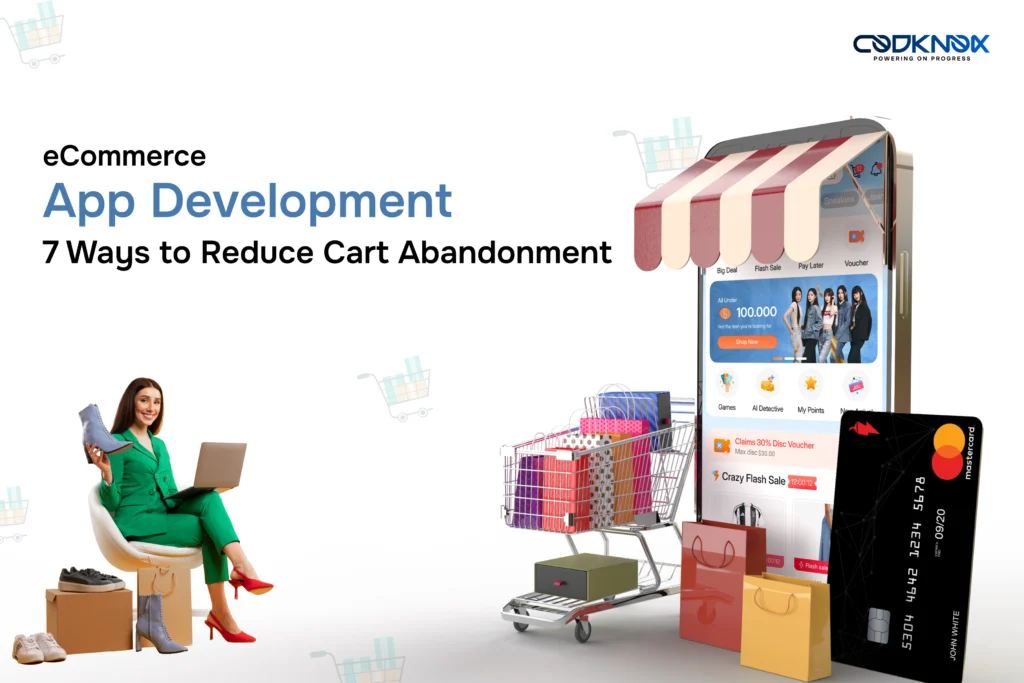
eCommerce App Development: 7 Ways to Reduce Cart Abandonment
Ah, the dreaded abandoned cart! It’s a real bummer for eCommerce businesses. Imagine spending hours building the perfect online store, only to have customers ditch their carts at the last minute. With nearly 70% of carts left behind (Baymard Institute, 2023), that’s a lot of “almost sales.” But don’t worry! As the best eCommerce development company in New York, USA your app can break the cycle finally. We need to understand the root causes and implement effective strategies for eCommerce app development to combat this. Why Does Cart Abandonment Happen? Source: Joint Research by Baymard and Statista Strategies that can Turn Cart Abandoners into Happy Shoppers 1. Make Checkout Faster Than a Cat Video Loading on WiFi Long, drawn-out checkouts are the ultimate cart killers. We have all been in a situation where you are almost ready to buy but the checkout process seems to go on forever. Did you know that conversion rates increased by 35% in 2023 just by streamlining checkouts (Baymard Institute)? What you should do: A streamlined checkout process is key to reducing cart abandonment. Minimize the number of steps. Ideally, it should take less than 5 steps. Keep the checkout form minimalist and focused. With today’s tech, customers want to zip through checkout like they’re ordering their morning coffee, not filling out a tax form. How about adding a progress bar? Give users that sweet dopamine hit of seeing just how close they are to snagging their item with a progress indicator. 2. Guest Checkout Because No Strings Attached Consider yourself at a checkout counter, and the cashier asks you to register an account before you can pay. Odds are, you’d leave, right? Forced account creation can feel like a hassle. You will notice fewer abandoned carts by offering a “guest checkout” option to your customers. What you should do: Get users through guest checkout and gently invite them to create an account after they’ve checked out. Consider a one-page checkout to further simplify the process. 3. Add Multiple Payment Options The one-size-fits-all approach is over. Customers want choices, and payment is no exception. If you only offer one or two payment options, you’re probably losing out on sales. What you should do: Offering more payment options is like having chocolate, vanilla, and strawberry at an ice cream shop. It just makes everyone happy. Expert eCommerce website development services know the importance of offering payment options like credit cards, digital wallets (like PayPal and Apple Pay), and even Buy Now, Pay Later (BNPL) to cater to more customers. Partner with a range of secure payment providers to support various payment options. Interestingly, BNPL options can increase conversion rates by allowing customers to spread out payments. Did you know that Juniper Research projects that between 2021 and 2026, consumer BNPL spending will nearly quadruple, rising 274%? Work with a seasoned custom mobile app development company in the USA, to build a captivating and fully functional online retail store. 4. Offer Mobile Optimization for a Smooth Ride on Any Device Two-thirds of online shopping orders are placed through smartphones, which accounted for about 77% of all retail site traffic worldwide as of the second quarter of 2024. (Statista) If your app isn’t as smooth on mobile as it is on desktop, you’re in trouble. Mobile shoppers are picky; if your buttons are tiny or pages are slow, they’ll bounce. What you should do: Ensure your site looks and functions flawlessly on all devices, offering a smooth mobile experience. Keep the buttons big and navigation clear. Make it easy for users to find what they need for intuitive navigation. The loading times should be lightning-fast to prevent impatient users from abandoning their carts. Optimize images, minimize code, and leverage browser caching. Do you want to know your eCommerce mobile app development cost? Our representative will help you. 5. Maintain Shipping Transparency Because Surprises are Fun Except When They’re Fees High shipping costs are a classic cart killer. Nobody wants to play Guess the Final Price! Customers don’t appreciate unexpected costs at the last step. 48% of users abandoned carts due to unexpected costs (Baymard Institute, 2023). Make sure your app isn’t one of them. What you should do: Make sure your shipping fees are transparent and, if possible, offer free shipping or set a minimum threshold to qualify. Be upfront about all fees, whether it’s shipping, handling, or service charges. Show them the full picture right from the start, and you’ll see fewer “back buttons” hit in frustration. Also, offer free shipping on orders over a certain amount to encourage larger purchases. It’s an incentive and a reward rolled into one! 6. Follow Up with Abandoned Cart Emails That Don’t Sound Like a Sales Pitch An abandoned cart email is a friendly reminder that brings customers back to finish their orders. The humble abandoned cart email is like sending a “Hey, don’t forget me!” message. What you should do: Strike while the iron’s hot by sending timely reminders to customers who abandoned their carts. The best ones keep it simple and warm and include the items left in the cart. Timing is everything; send the first reminder within 24 hours, then maybe a follow-up in 48 hours with a personalized discount or incentive to entice customers back. Keep it visual. Add images of the items left behind, a crisp message, and a friendly call to action: “Complete Your Purchase and Get 10% Off—We Miss You Already!” 7. Build Trust and Lay a Foundation of Confidence Imagine walking into a store where everything feels a little off. E-commerce customers are no different; they want to feel safe and confident while shopping online. Invest in trusted eCommerce website development services to build a reliable online store. What you should do: Trust badges from reputable security providers like Norton, McAfee, or your payment processor show customers they’re in safe hands. As a discreet reminder that you have got their security covered, proudly display these seals at checkout and even at
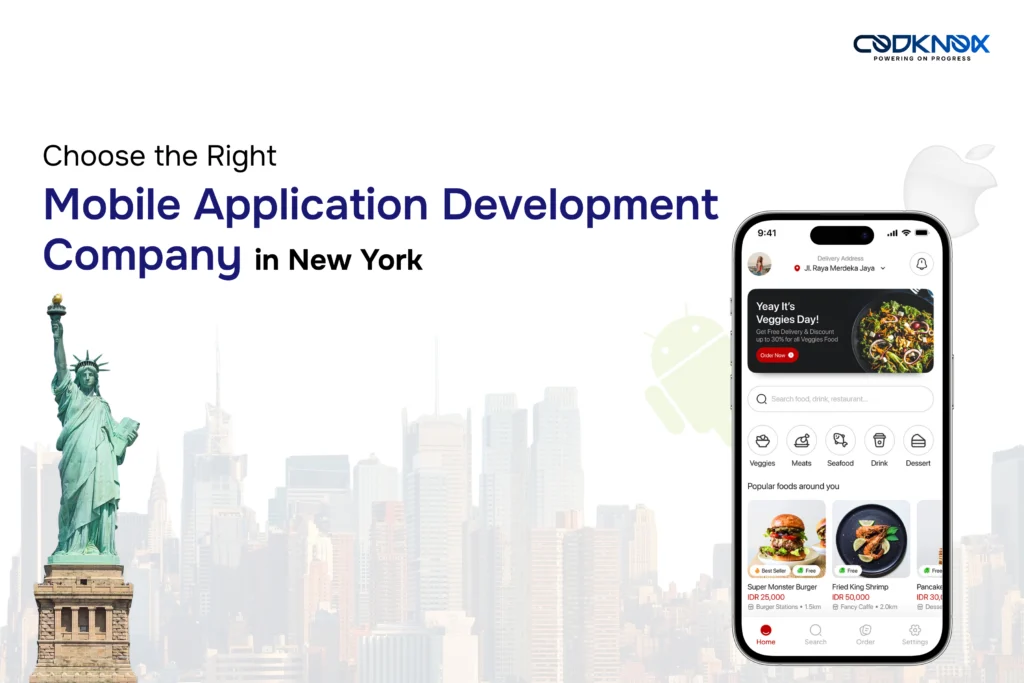
Choose the Right Mobile Application Development Company in New York
In the modern tech landscape brimming with talented developers, finding the best mobile app development company in New York, USA, can be as challenging as spotting a yellow cab on New Year’s Eve. Whether you’re cooking up the next social media sensation, a life-simplifying tool, an on-demand service solution, or a platform for gamers to unite, your project deserves a team with the right mix of tech-savvy, creativity, and reliability. Source: Market Research Future iOS, with a market size of $42.2 billion in 2022, shows steady growth, while Android is set to experience a more substantial surge, overtaking iOS by 2030. This data underscores Android’s dominant market trajectory, making it a key player for businesses and developers aiming to capture the mobile market in the coming years. With countless companies vying for attention and every developer claiming to be the best, how do you pick a team to help your app idea survive and thrive? By the end of this guide, you’ll have all the insider tips on choosing a team that brings the expertise, innovation, and collaboration you need to build a winning mobile application. 1. Define Your Needs Before Diving In Before you start looking for a development team, take some time to define exactly what you want from your app. What problem does your app solve? Who is your target audience? What features are essential for its success? Do you need it on iOS, Android, or both? Is this a basic app, or are you looking for custom integrations and advanced functionalities? Write down key points about your app’s purpose, target audience, and budget. Trust us this prep work pays off- saves you time and helps potential app developers in New York understand your project better. 2. Assess the Company’s Experience and Portfolio Not all companies have the experience or creativity you need. A company’s track record is a strong indicator of its capabilities. Check each company’s portfolio to see if they’ve handled projects similar to yours. Look for projects of app development in New York that showcase their ability to create visually appealing, user-friendly interfaces and robust functionalities. This reflects a developer’s understanding of both aesthetics and user experience. Pay attention to the complexity of their previous work and how well they’ve addressed challenges. 3. Evaluate Technical Expertise and Industry Knowledge Modern mobile apps are built on complex frameworks and updated technologies, from AI to augmented reality. Ensure that the company’s technical expertise isn’t just about coding; it’s also about staying updated with the latest tech trends, tools, and frameworks. A top company will know the latest advancements and offer insights on the best approach for your app’s specific needs. A company that understands your industry can provide valuable insights and ensure compliance. 4. Prioritize Communication and Transparency Your app is a huge investment, so you want a team that keeps you informed and involved every step of the way. Look for a company that values open and transparent communication. Discuss their project management methodologies, how they handle feedback, and their approach to collaboration. Look for mobile app developers in New York who respond quickly and keep you in the loop. Clear communication builds trust, making sure everyone’s on the same page from start to launch. 5. Balance Quality with Budget While budget constraints are natural, remember that you get what you pay for. While cost is important, prioritize quality and long-term value over short-term savings. Lower-cost development might sound appealing but could lead to compromises in quality. Instead, look for a mobile application development company in New York that offers transparent pricing and flexible payment options, like pay-as-you-go or milestone payments. 6. Evaluate the Development Approach, Focussing on Agile Methodology Effective project management can have a significant impact. Many successful companies from start-ups to large enterprises, use agile development, which offers flexibility and allows for adjustments along the way. This approach is perfect if you’re looking for iterative development, with feedback at every stage. Don’t hesitate to ask about their project management style. Teams with a well-defined approach keep things running smoothly, ensuring your app stays on schedule and within budget. 7. Check for Post-Launch Support and Maintenance Building an app isn’t just about launch day. Its success requires ongoing support and maintenance. Ongoing support for updates, bug fixes, and feature additions is essential. Inquire about the company’s post-launch services. A good mobile app development company will understand that as your users grow, so will your app’s needs. It will provide ongoing support to ensure your app’s continued success and address evolving business needs. Partner with the Best Mobile App Development Company in New York, USA Creating an app is a big deal, and we’re here to make it happen! We’re a team of passionate mobile app developers in New York who love building apps that stand out. With expertise in everything from design to post-launch support, we’re dedicated to creating mobile solutions that meet your unique needs. So, let’s talk. New York has plenty of developers, but there’s only one Codknox.
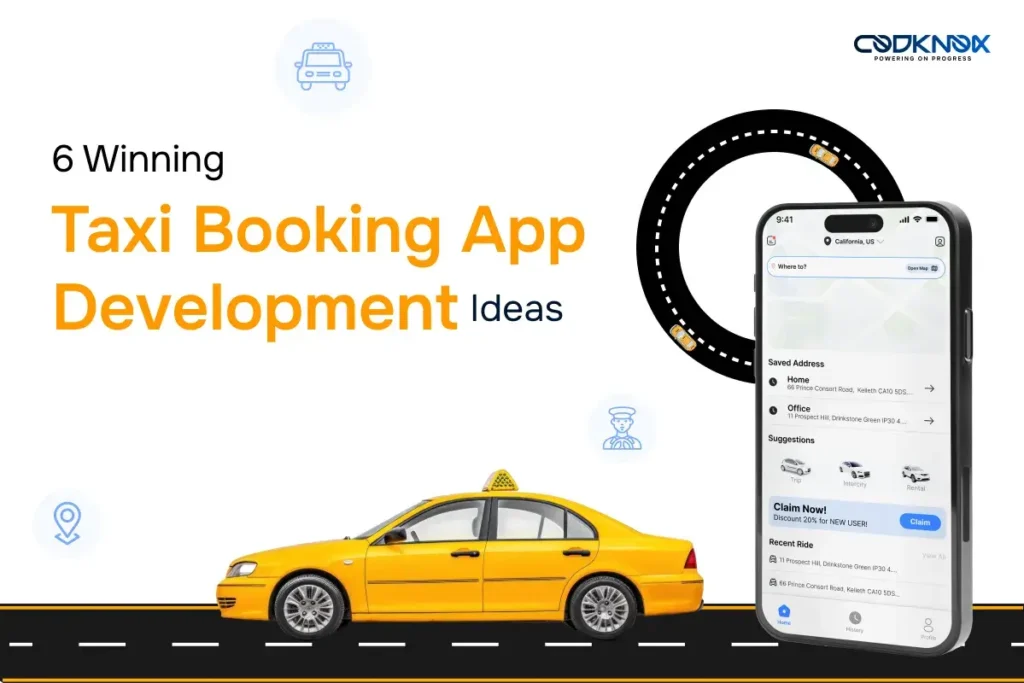
6 Winning Taxi Booking App Development Ideas
Nowadays, transportation entails more than just getting from one place to another. Convenience, comfort, and customization are the key components. There is a fantastic opportunity to satisfy a variety of client needs by developing taxi applications. Whether you are a new company or an established business, you can work with a trusted mobile app development company in New York, USA, to equip your business with a taxi app that meets these needs, and sets you apart from the competition. Let’s look at six creative ways to create taxi booking and taxi dispatch software in this blog post, which can completely change your taxi app business. 1. Ride-Sharing Taxi App Development Why it works: It taps into the growing demand for sustainable transportation. About the idea: Interested in making carpooling a lot more convenient for the passengers? It’s a smart move for them to both save money and reduce their carbon footprint. When people carpool, the driver picks up passengers traveling the same route, making it an economical and eco-friendly choice that cuts down on pollution and traffic congestion. Popular examples are taxi dispatch software like Uber, Lyft, and more. With this concept, you can attract two customer segments to your online taxi booking app business: those searching for affordable transportation and those interested in environmentally conscious travel. 2. On-Demand Taxi App Development Why it works: It meets the growing demand for convenient, flexible transportation options. About the idea: On-demand taxi services are an evergreen space in the transportation industry, offering passengers the flexibility of booking or scheduling a ride anytime, anywhere. Whether you’re targeting urban areas or rural communities, developing an on-demand taxi app allows for seamless user experiences with features like live location tracking, in-app payments, and in-app calling. CodKnox, a leading taxi booking app development company in New York, specializes in creating robust on-demand taxi apps that can scale with your business, ensuring that you stay ahead in this highly competitive market. 3. Luxury Car Rental App Development Why it works: It caters to high-end clientele seeking premium experiences. About the idea: For many, the appeal of luxury transportation for important events is undeniable, even if it remains out of reach for some. From upscale business meetings to elegant airport pickups and intimate celebrations like engagements and weddings, the desire to make a statement with a high-end vehicle is real. The magnificence and sophistication that luxury cars offer leave a lasting impression, making them the ideal choice for such occasions. With the help of luxury car rental apps, accessing these prestigious vehicles becomes effortless, catering to the growing demand for this service. The unique and tempting concept of integrating luxury car rentals into a taxi app is sure to captivate and retain a discerning clientele. 4. Women-Only Taxi App Development Why it works: It addresses a specific customer segment’s concerns and builds trust. About the idea: The safety of women is a major concern in numerous countries, especially when it comes to traveling. One promising solution is the introduction of gender-neutral vehicles in taxi services, which are operated and managed by women. By providing a safe and convenient means of transportation for women, these taxis can offer significant value to the public. With women comprising nearly half of the global population, there is a substantial market opportunity for women-friendly taxis. Although these services have been introduced in several US, Middle Eastern, South African, and Indian cities, a lack of digital applications and a dearth of female drivers have made it difficult for them to become widely used. The potential for the concept to gain traction and make a significant impact on the taxi app development market is evident if popular taxi dispatch software like Uber were to be introduced. Connect with a seasoned mobile app development company in New York, USA, to dig deep into this app development space. 5. Healthcare Taxi App Development Why it works: It addresses a critical need for reliable and accessible medical transportation, especially for those with disabilities or limited mobility. About the idea: The importance of medical transportation services has been highlighted by the COVID-19 pandemic. The pandemic has brought attention to the life-saving potential of ambulances and medically equipped vehicles due to their accessibility. Because of these benefits, there will always be a need for healthcare transportation services even after the pandemic. One strategy that can work well is to focus on people who have elderly or ill family members living with them, as they are more likely to need emergency transportation services. Collaboration with hospitals or healthcare facilities can enhance the promotion of your taxi dispatch software to reach the desired audience. Additionally, the delivery of patient care has been completely transformed by the integration of on-demand apps for scheduling doctor appointments with healthcare transportation services, greatly enhancing patient-provider communication. 6. On-Demand Chauffeurs Service App Development Why it works: It caters to those seeking a premium, personalized travel experience, often a VIP package. About the idea: The ease with which one can travel at any time without worrying about driving, combined with the added luxury of having a personal driver available when needed, is completely changing the way people commute. Due to this trend, companies are actively looking for specialized teams to create cutting-edge on-demand chauffeur booking apps and are investing in this beneficial service. Convenience is important, but to improve the user experience overall, add features like safe payment methods, driver preferences, and real-time tracking. Related Article: How to Build An App Like Bolt: A Complete Guide Key Features for Taxi App Development When developing a taxi app, incorporating the right features is crucial for ensuring user satisfaction and streamlining operations. Here are some prominent features that a trusted taxi booking app development company in New York can offer your targeted audience: By incorporating these innovative ideas and focusing on a superior user experience, you can create a taxi app that stands out in the market. Consider partnering with CodKnox, a trusted taxi booking app development company